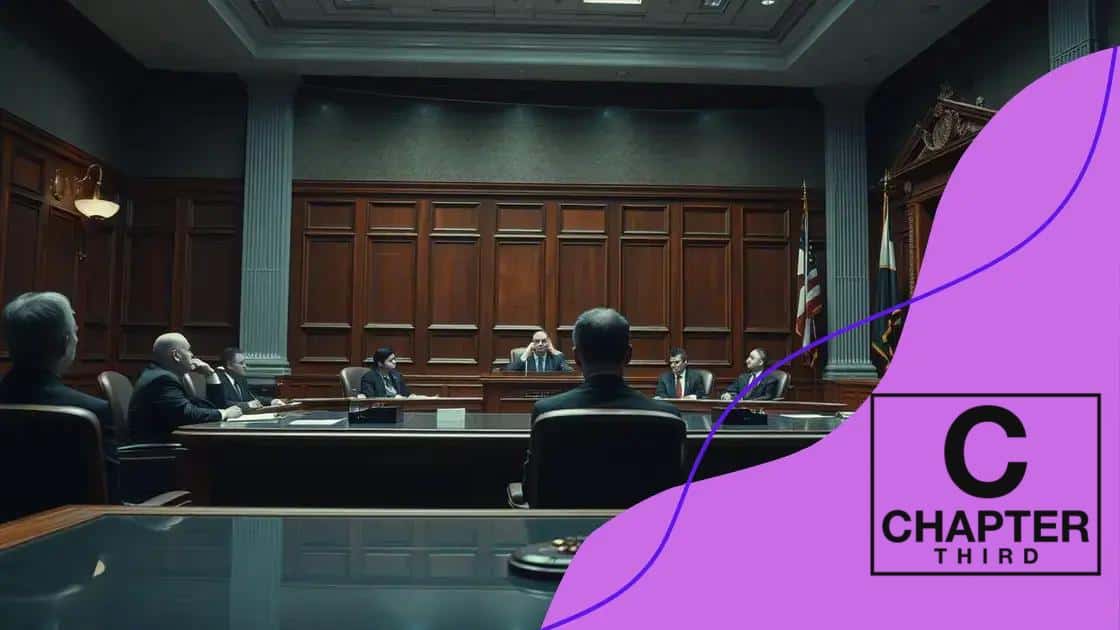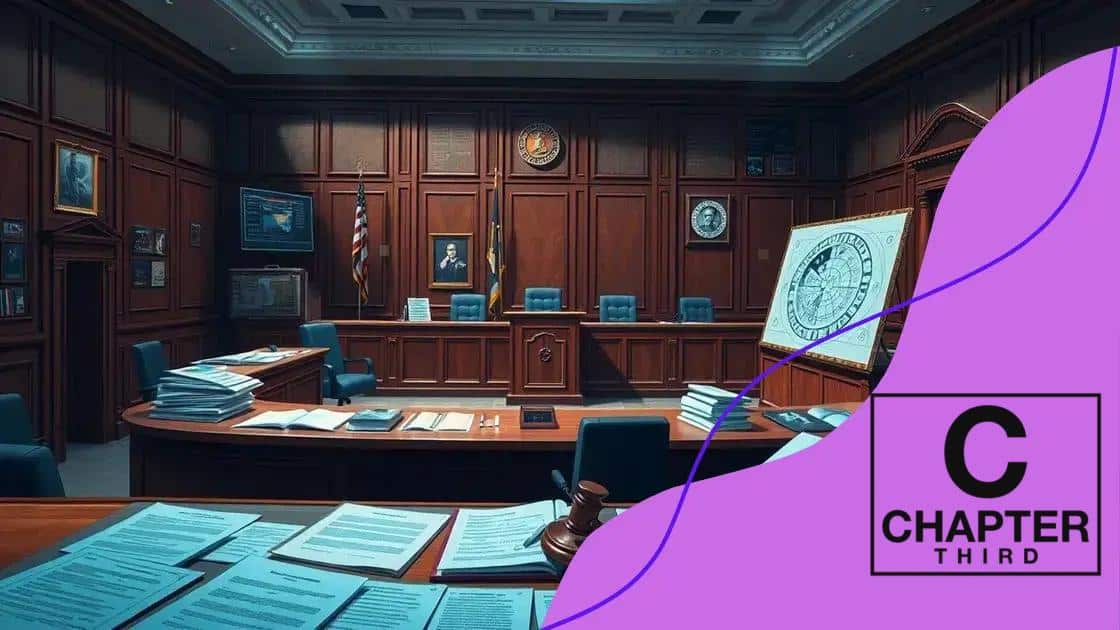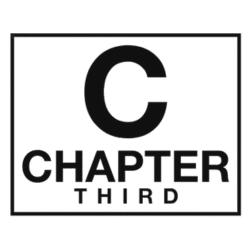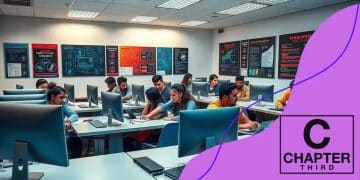AI-generated art sparks legal battles over copyright

AI-generated art raises complex issues regarding artistic ownership, as it blurs the lines of authorship and copyright, necessitating new legal frameworks to protect creators while fostering innovation.
AI-generated art sparks legal battles as creators and tech developers navigate the murky waters of copyright in this fast-evolving domain. Have you ever wondered how artificial intelligence reshapes the art world and the laws that govern it? Let’s dive in.
Understanding AI-generated art
Understanding AI-generated art is essential as it shapes the future of creativity and technology. This art form combines algorithms and human creativity, leading to new possibilities in artistic expression.
What is AI-generated art?
AI-generated art is created using artificial intelligence technologies that simulate human creativity. These systems analyze vast datasets of existing artworks and create new pieces based on learned patterns. It challenges traditional concepts of authorship and originality.
How it works
AI art systems involve complex processes such as machine learning and neural networks. They “learn” from previously created artworks, recognizing styles and elements. This allows for unique creations that can mimic various art movements, from impressionism to modern abstraction.
- Machine learning algorithms analyze thousands of images.
- Neural networks generate new art based on learned styles.
- Artists can input parameters to guide the AI’s creativity.
As artists engage with these technologies, they often serve as collaborators rather than traditional creators. This interaction leads to a blend of human intuition and machine efficiency, producing unexpected and innovative results.
Moreover, AI-generated art raises questions about the artistry and intention behind such works. Can a piece of art created by an algorithm be considered genuine? This topic fuels passionate discussions in both artistic and legal arenas.
The implications for artists
For many artists, AI tools provide new ways to express their vision. They can explore styles and concepts that were previously unattainable. However, there are concerns about the impact of AI on traditional artistry. Some fear that these technologies may overshadow human creativity, while others view them as tools to enhance it.
As the industry evolves, understanding AI-generated art becomes crucial. It enables both artists and audiences to navigate this new landscape thoughtfully.
Legal implications of AI art
Legal implications of AI art are becoming increasingly complex as this form of creativity grows. As artists and technologists create new works, they navigate various legal challenges that could redefine copyright, ownership, and the nature of art itself.
Copyright challenges
One of the primary legal issues surrounding AI-generated art is copyright. The question arises: who owns the artwork created by a machine? Typically, this ownership is attributed to the person who programmed the AI or provided the data. However, there is no clear consensus on this.
- Ownership often depends on the AI’s role in the creative process.
- Legal frameworks vary widely by country, creating confusion.
- Artists may find themselves in disputes with AI developers.
These copyright dilemmas challenge long-standing notions about creativity and authorship. As the technology evolves, so must our legal understanding of who can claim a piece of AI-generated art.
Perceived value and authenticity
The concept of authenticity is also at stake when it comes to AI art. Can a piece created by an algorithm hold the same value as one made by a human hand? This question influences how artworks are marketed and sold. Some collectors seek out AI-generated pieces, while others remain skeptical about their worth.
As AI art gains traction, market dynamics shift. Traditional galleries are now showcasing AI-generated pieces alongside works by human artists. This trend highlights a growing acceptance of AI’s role in the art market, yet it also raises further legal questions regarding representation and rights.
Additionally, issues related to plagiarism and originality arise. Algorithms can inadvertently replicate existing styles, leading to potential theft of ideas. As a result, legal protections around originality must adapt to account for these new technologies.
Future considerations
Looking ahead, legal frameworks must evolve to address the unique challenges posed by AI in art. Policymakers need to consider how copyright laws can protect artists while encouraging innovation. Ongoing discussions in legislative bodies aim to clarify rights and responsibilities as AI continues to shape the creative landscape.
Ultimately, as society integrates AI-generated art into everyday life, it will be vital to establish clear legal protections that safeguard both creators and technologies involved.
Key cases in AI copyright disputes

Key cases in AI copyright disputes illustrate the evolving legal landscape surrounding artificial intelligence and creativity. As AI-generated works become more common, several legal battles have emerged, setting important precedents for copyright law.
The Thaler case
One notable case is that of Stephen Thaler, who claimed copyright for an artwork created by his AI system, named DABUS. Thaler argued that since DABUS created the work independently, it should be recognized as the author. This case raised questions about whether machines can hold copyright. Ultimately, courts in various jurisdictions made differing rulings, reflecting ongoing uncertainty in the law.
The case of ReDigi
The ReDigi case, while focused on selling digital music, has implications for AI-generated art. ReDigi, a platform allowing users to resell their legally purchased digital music, faced legal challenges from record companies. The outcome emphasized the need for clear copyright guidelines in the digital age, suggesting that similar principles may apply to AI art.
- ReDigi’s model questioned ownership rights in digital goods.
- Rulings could influence how AI art is bought and sold.
- Legal clarity is crucial for digital marketplaces.
These cases reveal the complexities of applying traditional copyright laws to modern tech. As legal systems grapple with these issues, artists and technologists must stay informed about their rights and responsibilities in the evolving landscape.
Emerging precedents
More recent cases continue to shape our understanding of AI rights. For instance, several artists have challenged AI systems that create art based on their styles without consent. These disputes highlight the tension between innovation and intellectual property, calling for updated legal frameworks that accommodate new technology.
As these cases progress, they contribute to a larger conversation about the future of art and copyright. Artists, lawyers, and technologists must collaborate to ensure innovation does not come at the expense of rights.
Future of copyright in the age of AI
The future of copyright in the age of AI is a topic of intense debate among artists, lawyers, and technologists. As AI continues to produce creative works, traditional copyright frameworks face significant challenges. These changes will impact how artworks are created, shared, and protected.
Adapting copyright laws
One major concern is how existing copyright laws can adapt to the rise of AI-generated content. With machines creating art, music, and literature, there is a pressing need to define authorship. Should credit go to the creator of the AI, the user who prompted the creation, or the AI itself? This question remains unresolved.
- Copyright laws may need redesigning to include AI as a creator.
- Courts will likely see more cases involving AI-created works.
- Legislation must consider new forms of digital creativity.
As new legal definitions emerge, it’s crucial to ensure that artists maintain rights over their creations while promoting innovation. Balancing these interests will be key for future legal frameworks.
New business models
The rise of AI art also opens doors for new business models. Artists might begin collaborating with AI tools to create unique pieces, changing how art is produced and sold. Such collaborations could lead to licensing agreements that protect both human and machine contributions.
Furthermore, platforms that sell AI-generated art may need to establish clear policies regarding ownership and pricing. As AI-generated works become more prevalent, consumers will seek assurance about the legality and authenticity of their purchases.
The technology continuing to evolve means that traditional notions of scarcity in art may shift. As more pieces are created rapidly and at a lower cost, the art market might experience a transformation.
The role of ethics in AI art
Ethics will play a vital role in how copyright evolves. Questions about fair use and plagiarism will become more pressing as AI systems generate art based on existing styles. Policymakers, artists, and technologists must engage in conversations about the ethical implications of AI in creativity.
As society navigates this landscape, fostering collaboration between stakeholders is crucial to creating a legal framework that reflects the reality of AI-generated art. This collaboration will help define rights and responsibilities moving forward.
Artistic ownership and AI creations
Artistic ownership and AI creations are complex subjects as technology evolves. As AI systems generate art, questions about who really owns these pieces arise. This debate impacts artists, developers, and consumers.
Understanding ownership
Traditionally, artistic ownership is clear: the creator holds the rights. However, in the case of AI, the scenario becomes murky. If an AI generates a piece, is the software developer, the user, or the machine itself the owner? These questions lead to a deeper understanding of creativity and rights.
- Ownership may depend on the input provided to the AI.
- The level of human involvement influences rights.
- Current laws may not apply directly to AI outputs.
This ambiguity creates challenges for artists seeking protection for their works created with AI assistance.
Collaboration between artist and AI
Many artists now collaborate with AI tools, merging human intuition with machine efficiency. This partnership enriches creative processes but complicates ownership. When artists use AI, they blend their ideas with the machine’s interpretation. This collaboration raises new questions about how to credit and protect the final artwork.
As artists explore these tools, it may lead to unique art styles that challenge traditional norms. The emergence of AI as a collaborator invites discussions on the evolving definitions of authorship and originality.
The role of licensing
Licensing agreements also play a significant role in defining ownership. Artists can license their works generated by AI, ensuring they retain rights over the generated content. Licensing can help clarify the rights of all parties involved, enabling a fair system that respects both human creativity and AI-generated innovation.
As the art world adapts, new licensing frameworks must evolve to cater to AI creations, providing clear guidelines on ownership and use.
FAQ – Frequently Asked Questions about Artistic Ownership and AI Creations
Who owns the art created by AI?
Ownership can vary; it may belong to the AI developer, the user, or the AI itself, depending on the involvement in the creation process.
How can artists protect their rights with AI-generated works?
Artists can utilize licensing agreements to ensure they retain rights over AI-generated content.
What legal challenges arise with AI art?
Key challenges include determining authorship, adapting copyright laws, and addressing ethical concerns around originality.
What does the future hold for art and AI collaboration?
The future will likely see more collaborations between artists and AI, leading to new forms of creativity and evolving legal frameworks.






